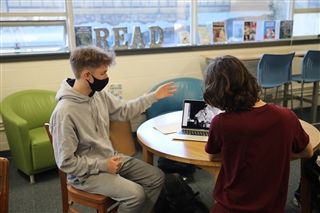For the first time, the Grade 11 IB Theory of Knowledge students held an exhibition to present and discuss their cumulative projects.
Students started by picking a knowledge question from a list of 35 prompts and then used their critical thinking skills to explore the concept. They picked three examples or objects from their world as a way to illustrate different aspects of that question. They then prepared an approximately 300-word write-up on each object.
Hopper Kendregan ’22 chose to do her project on “What is the relationship between culture and knowledge?” She chose three objects that meant something to her and that would allow her to answer her chosen prompt.
First was a photo of her family at the reinstatement of her great-grandfather’s boat “Nishga Girl” into the Canadian Museum of History in 2013. During the Second World War, Hopper’s great-grandfather and his family were sent to Japanese internment camps. While he was being held there his friend Hereditary Nishga Chief Eli Gosnell helped to save one of his boats. She said the image was a representation of the unique bond between Japanese-Canadians and First Nations people in the Pacific Northwest, as it showed how their cultures have informed their shared knowledge and created a bond between their communities.
“All of the Japanese men in my family have been fishermen, and a lot of the Indigenous communities up there, including the Nishga people, fished for a very long time. They lived off of the salmon,” explained Hopper. “They had that shared common knowledge from their culture, of the best fishing spots, and bait, but they also had that deeper level of connection from the alienation they had faced from white people in the communities of Prince Rupert and Port Edward, and the systemic discrimination they faced from the Canadian government. Those things were very informed by their culture.”
For her second object, to showcase the relationship between culture and knowledge, Hopper chose to use the book Complementary and Alternative Veterinary Medicine, which her boss and mentor lent her.
“I wanted to use it to represent the different ideals in Western and Eastern medicine, and how those things are valued in Western culture,” she said. “Throughout the book and with my boss as well, they talk about Eastern medicine complementing Western medicine, and I think that is something often dismissed in Western culture…It shows you don’t have to choose between Eastern and Western medicine. They have different ideas but at the same time they both have a lot of value.”
The final object Hopper used to illustrate her prompt was the album “Animism” by Tanya Tagaq, an Inuit throat singer.
“I think it’s a unique way for her to share her knowledge. It’s a skill that has been passed down throughout her culture and it isn’t typically shared with any communities outside of her culture,” she said. “A lot of her songs are a political statement…and she can share her political beliefs and her knowledge using her cultural skill of throat singing.”
Eya Ibrahim ’22 picked the prompt of “Who owns knowledge?” She tilted her work, Exploitation, knowledge, ownership. For her three objects, she chose turmeric, the book The Immortal Life of Henrietta Lacks, and Kim Kardashian wearing traditional cornrows.
“All of these three objects, I decided to take a lens of minorities in knowledge ownership because they are often overlooked and I find that’s wrong and something that needs to be considered especially if we have the debate over knowledge ownership,” she said.
With turmeric, she explored the idea of how Indigenous people are often taken advantage of. She explored how turmeric has been used in many cultures for centuries but was patented by two American scientists without recognition of these other cultures.
“I talk about how it’s wrong and how we have to conform to society’s rules, and how that is inherently wrong, and how we can establish a basis of consent,” she explained.
Using her second object, Eya explained how Henrietta Lacks was diagnosed with cervical cancer and that her cells were used without her consent. After she died, her cells were used for research and are called HeLa cells, which are the oldest and most commonly used human cell lines in scientific research.
“Big companies have profited and made millions off of them, while her family wasn’t even compensated,” said Eya. “I talked about the idea of how she was an African-American woman and didn’t even know what a cell was, and was used as a factor to exploit her and her cells without credit to her or acknowledging where the cells came from.”
Eya also used a photo of Kim Kardashian wearing cornrows. After kim was pictured wearing the braids, they were called KKW signature braids, even though they have been used by other cultures for centuries.
“I talk about adopting black features, like skin tone, hair, language and music is always appreciated when it comes from a white artist or celebrity, but it’s not recognized or celebrated when it comes from those that are creating the very things,” she explained. “I also talk about how celebrities tend to pick and choose whatever features they like, without addressing the real root issues that exist with systemic racism.”
The Theory of Knowledge exhibition is a new component of the course this year, but has proved to be an amazing way for the students to demonstrate how this course has taught them to think deeply about topics that resonate strongly with them personally.





